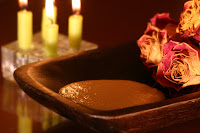
Anticipation is a wonderful thing. Anticipation stimulates imagination, and gives even the dull chores of the day a kind of momentum. Like when I was was a potter in the mountains of New Mexico. I would fire a kiln, and then have to wait for it to cool before I opened it. Would it contain unexpected treasures created by the magic of fire and air and chemicals, or would I have yet another "learning experience"?
During the hours it took for the kiln to cool down, I would often turn into "The Mad Gardner": pulling weeds, watering, squinting at the tomato vines in order to find those cleverly camoflaged tomato horn worms. The garden flourished because I had to wait. Sometimes the house got cleaned and the laundry washed and hung out to dry in the warm, juniper scented New Mexican air.
During the hours it took for the kiln to cool down, I would often turn into "The Mad Gardner": pulling weeds, watering, squinting at the tomato vines in order to find those cleverly camoflaged tomato horn worms. The garden flourished because I had to wait. Sometimes the house got cleaned and the laundry washed and hung out to dry in the warm, juniper scented New Mexican air.
While I was waiting to hear from the State to know if I had passed my acupuncture boards, I drove up the coast to Big Sur with a friend. I had always wanted to visit this spectacular section of the California coast, and it certainly lived up to my anticipation. The winding roads, the mountains on one side and the ocean on the other, the bold, craggy rocks jutting out of the sea, the weathered houses dotting the hills, the brisk air.....all of it brought to mind stories of Henry Miller and Jack Kerouak. Anticipation became limited to what we might discover around the next bend in the road....a place to pull over and watch the sea otters. A funky restaurant with out of this world soup. A group of bikers from Germany who played guitar and sang at night.
These days, I'm focused on my website and writing articles on a variety of health issues and publishing them on the web. It helps divert my attention from the fact that on April 2nd I travel to Chicago, and on April 3rd I fly to Delhi. I must not spend too much time thinking about it. If I do, the laundry would not get done, the house would not get cleaned. INDIA!
There. I wrote it. It's real.
Why am I going? Because my eldest brother called me and asked "Wanna go to India?" What was I supposed to say - "No"? I don't think so. The photographer in me is shaking in anticipation. The foodie in me couldn't wait. So while Hollywood was lavishing awards on their best and most talented, I decided to make a dish which I found in Classic Indian Cooking, by Julie Sahni. Needless to say, what I did wasn't exactly what the recipe called for. It reflected what I had in my kitchen. I've discovered a gap in my spices, which will be filled the next time I go to the store. I will give the recipe as it's given in the book, and you may tinker with it as you wish.



1 small head cauliflower (about 1 - 1 1/4 pounds)
2 medium sized potatoes (about 1/2 pound)
1/2 cup ghee or light vegetable oil
2 tsp cumin seeds
1 tsp ground cumin
2 Tbs ground coriander
1 tsp turmeric
1/2-1 tsp. red pepper
1 1/2 cups shelled fresh green peas, or 1 ten ounce package frozen peas, defrosted
1 1/2 cups pureed or finely chopped fresh ripe tomatoes, or 3/4 C canned tomato puree
4 tsp. Kosher salt
3 Tbs. finely chopped fresh coriander leaves (or 1 1/2 Tbs dry coriander leaves)
1. Wash cauliflower in running cold water. Break or cut it into about 1 1/2-inch flowerets. Peel the central stem and cut into 1/4 inch thin slices.
2. Peel potatoes and cut each into 6 pieces
3. Measure out all spices and place them, and all the veggies next to the stove.
4. Heat the ghee over medium-high heat in a deep heavy-bottomed pan. When the fat is hot, add the cumin seeds, and fry until they turn dark brown (about 20 seconds). Add cumin powder, coriander, turmeric, and red pepper all at once. Stir for a moment and immediately add cauliflower, potatoes, and fresh green peas. (If you are using frozen peas, do not add them yet). Fry, stirring constantly, until the vegetables begin to sear a bit (about 5 minutes). Add tomatoes (or puree) and continue frying until the puree thickens and the fat begins to separate from the sauce (about 3 minutes). Add 3 cups boiling water along with th esalt. Reduce heat and simmer vegetables, covered, until they are tender and cooked through(about 15 minutes). If you are using frozen peas, add them now, and continue cooking for an additional 5 minutes. Turn off heat. Check for salt, and serve sprinkled with chopped coriander leaves.
For health news, visit Mission Valley Acupuncture






 So when you're done eating all those Valentines chocolates, when the flowers have become droopy, and the weather continues in relentless winter dreariness, consider the warmth and comfort of some chili.
So when you're done eating all those Valentines chocolates, when the flowers have become droopy, and the weather continues in relentless winter dreariness, consider the warmth and comfort of some chili.

 For news about health, visit
For news about health, visit 











